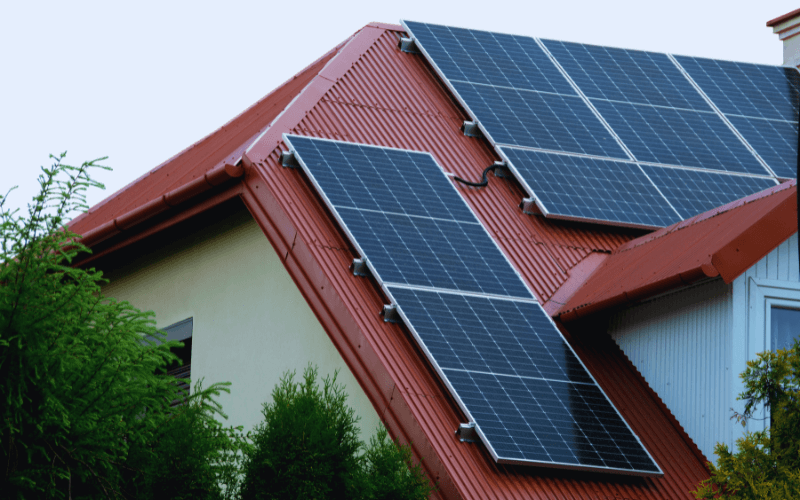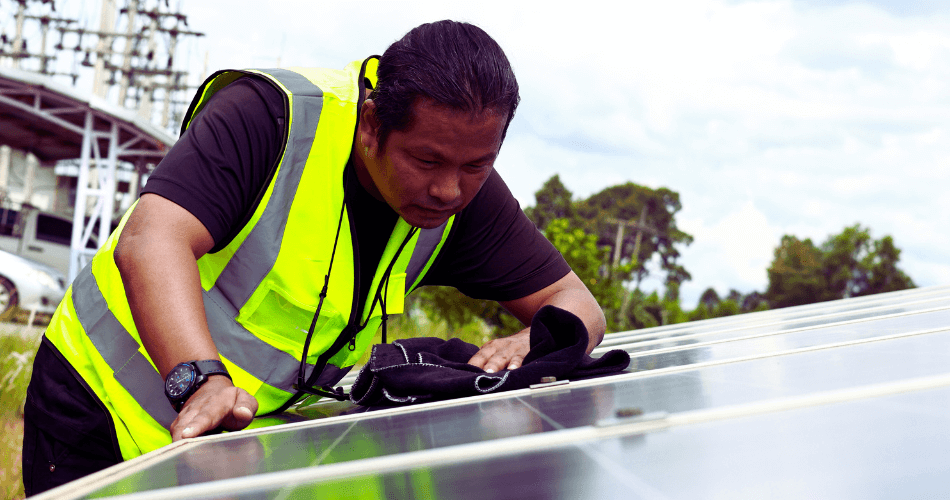When it comes to solar panel installation, the angle at which you mount your panels is crucial. This angle directly impacts the amount of sunlight your panels can capture and convert into electricity. Let’s dive into the details to help you make the most out of your solar setup.
Table of Contents
Why the Angle and Direction of Your Solar Panels Matter
Getting the angle and direction of your solar panels right can make a significant difference in your energy production. The goal is to maximize sunlight exposure and, in turn, energy efficiency. In the northern hemisphere, you want your panels facing south. Conversely, in the southern hemisphere, aim them north. This orientation ensures your panels receive the most sunlight throughout the day.
The tilt angle of your solar panels is just as important. It determines how directly sunlight hits the panels. The optimal angle often matches your location’s latitude. This means if you live at 34° latitude, you should tilt your panels at around 34° for the best results. This angle ensures maximum energy collection efficiency, adjusting for seasonal variations.
Finding the Perfect Solar Panel Angle for Your Location
Determining the right angle for your solar panels involves a bit of calculation and consideration of seasonal changes. Here’s how you can do it:
1. Use Online Tools and Calculators: Websites like the World Bank Global Solar Atlas offer detailed information about local solar resources, including the optimum tilt angle for your panels. Simply input your location, and you’ll get the best angle for maximum efficiency.
2. Adjust for Seasons: Generally, you’ll want to adjust your panels’ tilt angle depending on the season. During winter, increase the angle by adding 15° to your latitude. In summer, decrease the angle by subtracting 15°. For example, if your latitude is 34°, tilt your panels to 49° in winter and 19° in summer.
3. Consult Experts: Sometimes, consulting with solar installation professionals can provide insights tailored to your specific location and setup. They can help fine-tune the angle for optimal performance year-round.
Factors Influencing Solar Panel Direction
Choosing the right direction for your solar panels involves considering several factors:
Shading: Ensure there are no obstructions like trees or buildings casting shadows on your panels. Even partial shading can significantly reduce your energy output.
Roof Orientation: If your roof doesn’t face the ideal direction, you might consider installing additional panels on the east and west sides. This can help capture sunlight during morning and evening hours, balancing your energy production throughout the day.
Aesthetics and Maintenance: Sometimes, visual appeal and ease of maintenance are crucial. Make sure your panels are accessible for cleaning and maintenance, and don’t compromise the look of your property.

Maximizing Energy with East and West-Facing Panels
An interesting approach is using a combination of east and west-facing panels. This setup, known as an east-west split, can provide a more consistent energy output throughout the day. Here’s why it works:
Balanced Production: East-facing panels catch the morning sun, while west-facing panels capture the afternoon sun. This balance can smooth out your energy production curve, especially useful if your household’s energy consumption varies throughout the day.
Inverter Configuration: Ensure the panels are identical in number and type, and connect them properly to your inverter. This setup maximizes efficiency and prevents any panel from dragging down the system’s performance.
Lower Tilt Angles: Typically, east-west setups use a lower tilt angle, around 15°. This reduces shading issues and allows for more panels in a given area.
Roof Pitch and Solar Panel Tilt
The pitch of your roof plays a significant role in determining the tilt angle of your solar panels. Here’s how it works:
Flush-Mounted Panels: For typical roofs with a pitch of 15-22.5°, flush-mounted panels will have a similar angle, which is often close to the optimal tilt for your location. This setup is cost-effective and straightforward.
Flat Roofs: If your roof is flat, mount your panels at a tilt of at least 10° to ensure water runoff and self-cleaning.
Seasonal Adjustments: It’s also worth noting that the optimal angle can vary with seasons. During winter, a steeper angle captures more sunlight, while in summer, a shallower angle works best. However, constantly adjusting your panels is impractical for roof mounted systems. Sticking with your roof’s angle or a fixed tilt frame is usually the best approach for most homeowners.
Practical Tips for DIY Solar Enthusiasts
For those of us who love a good DIY project, setting up solar panels can be both exciting and rewarding. Here are some practical tips:
Embrace Your Roof’s Angle: Most roofs have a pitch between 15° and 36°. Often, this pitch is already close to the ideal year-round angle for your location. Installing your panels flush with the roof can save you from the hassle and cost of tilt frames, especially if the energy gain from adjusting the angle is minimal.
Consider Ground Mounts: If your roof isn’t suitable, ground mounts offer flexibility. You can easily adjust the tilt throughout the year to capture maximum sunlight. Seasonal adjustments can significantly boost your system’s efficiency, especially in locations with pronounced seasonal changes.
Use Simple Tools: There are handy tools available, like solar panel stand legs and angle calculators. These can help you set the perfect tilt without needing to get out your protractor. They’re particularly useful for ground-mounted systems or off-grid setups like hunting cabins or cottages.
In practice, the perfect angle for solar panels is often simply the angle your roof already has. The difference in energy output is usually just a few percent less compared to adjusting with tilt frames. So, don’t stress too much about getting the perfect angle. Just install the panels flush with your roof and enjoy decades of lower electricity bills.
For example, I designed an off grid solar system for Adelaide, and the perfect angle for solar panels there was 29 degrees. That roof is at a 15-degree angle from the horizontal. So, should I install tilt frames to adjust the angle to 29 degrees? Not necessarily. I decided to lay those panels flat at 15 degrees, matching that roof’s angle. After doing the math, I realized that the difference in energy output between 15 degrees and the ideal 29 degrees is a mere 4% per year. Given the cost and aesthetic concerns of installing tilt frames, the extra energy output wasn’t worth it.
Summary
To sum up, while the perfect angle and direction of your solar panels can boost efficiency, the practical approach is to install them according to your roof’s existing pitch and face them north (in the southern hemisphere) or south (in the northern hemisphere). This setup will provide you with substantial energy savings without the hassle and expense of tilt frames. So, relax, install your panels, and start saving on your energy bills!
